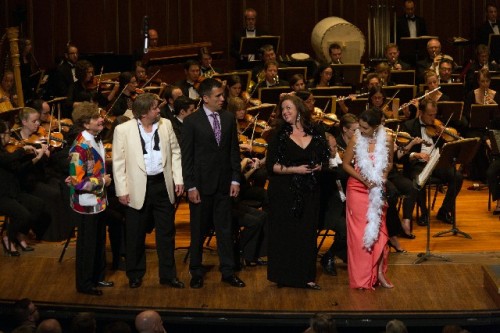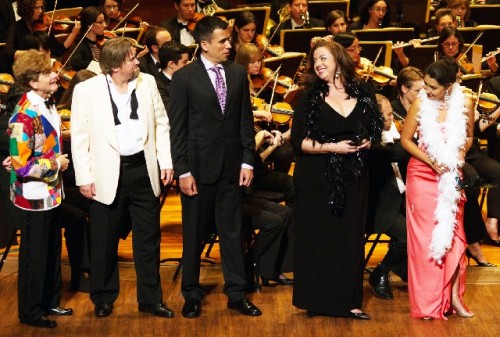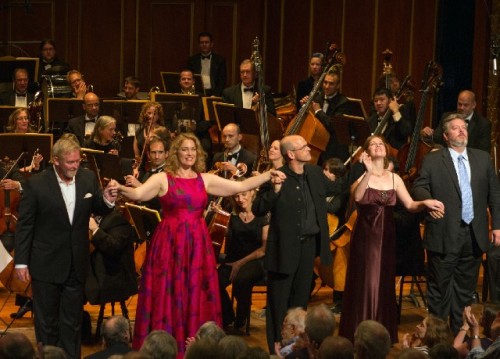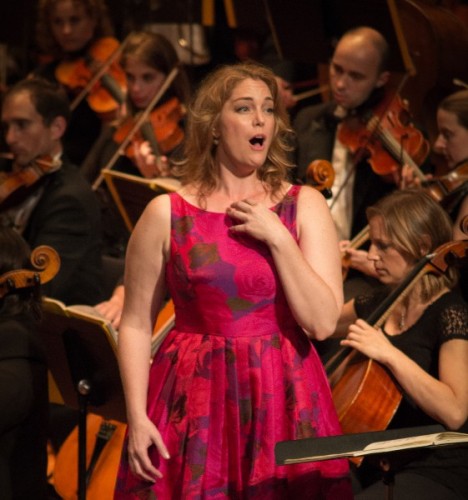Die Tote Stadt (The Dead City)
Boston Premiere for Korngold Rarity
By: David Bonetti - Sep 16, 2014
“Die tote Stadt” (The Dead City)
Music by Erich Wolfgang Korngold (1897-1957)
Libretto by Korngold and his father Julius Korngold (using the pseudonym Paul Schott)
Premiered simultaneously in 1920 in Hamburg and Cologne
Boston premiere Sept. 13, 2014 by Odyssey Opera
Gil Rose, artistic and general director
At Jordan Hall of the New England Conservatory
A concert performance
With Odyssey Opera Orchestra
New World Chorale and a Youth Chorus
Conductor: Gil Rose
Cast: Paul (Jay Hunter Morris); Marietta/Marie (Meagan Miller); Frank, Paul’s friend (Weston Hurt); Brigitta, Paul’s housekeeper (Erica Brookhyser); Fritz, an actor (Thomas Meglioranza); Victorin, the director (Frank Kelley); Juliette, a dancer (Sara Heaton); Lucienne, a dancer (Janna Baty); Count Albert (Alan Schneider); Gaston, a dancer (Jonas Budris)
What can you say about a composer who wrote his greatest work when he was 23 and lived another 37 years, prolific and prosperous but never able to reach the artistic heights he did when he was a child prodigy? Over the years critics have said that he was a hack, selling out to Hollywood, where he wrote film scores for such Errol Flynn vehicles as “The Adventures of Robin Hood” and “The Sea Hawk” and “Of Human Bondage,” the film that made Bette Davis’s career. His defenders have written that he created a new symphonic style for the talkies, bringing the rich tonal world of Wagner, Strauss and Mahler, full of leitmotifs, to the popular audience. His influence endures to the present day in the film scores of John Williams.
But that all came after “Die tote Stadt,” an international hit when it first appeared, but which fairly quickly disappeared and is only now receiving its first Boston performance. (Its fall from popularity had a lot to do with the cultural anti-Semitism that accompanied the rise of the Nazis – Korngold was Jewish. After the war, it seemed hopelessly old-fashioned, and his career as a “serious” composer ruined by his film work, it was not revived until the 1970s.)
But at its premiere, “Die tote Stadt” was a true phenomenon, a popular and critical success. Giacomo Puccini, who cribbed a chorus from the work for “Turandot,” which premiered only 3 years later, called Korngold “the strongest hope for new German music.” Earlier, he had been celebrated as a prodigy by everyone from Mahler and Brahms to younger composers like Schoenberg, Webern and Berg.
If you like fin-de-siècle decadence – and these days, when we’re living through our own period of seemingly endless fin-de-siecleism, who doesn’t? – you’ll love “Die tote Stadt,” which could serve as a check-list for the condition Korngold’s older contemporary, the Viennese analyst named Sigmund Freud, limned so well. Stuck in the past? Got it. Obsessive? Got it. Worship the dead? Got it. Repressed sexuality? Got it. Religiosity? Got it. Fetishism? Got it. Art for art’s sake? Got it.
In the dead city of Bruges, Korngold creates a sticky, sickly hothouse atmosphere for his neurotic characters to play in. When Marietta, a carefree dancer in an opera company from France, enters Paul’s house, which has been turned into a memorial to his dead wife Marie, she compares Paul with Bruges, a dead man in a dead city, and finds the house stuffy, running to open the curtains to let the sunshine in. (Throughout the symbolist work, Marietta is shown to be synonymous with sensuality and life, Paul with spirituality and death.)
Based on the novel “Bruges-la-Morte,” later adapted as a play, by French symbolist Georges Rodenbach, the story of “Die tote Stadt” is relatively simple – until it gets confused with its own symbols and time-line. Paul is a prosperous Bruges burgher, mourning the death of his wife Marie. On the street one day, he espies a woman, Marietta – little Marie - who is her double. He invites her to his home, where she mocks him for being in love with death. She soon leaves to rehearse with her dancing troupe their scene from 19th century composer Meyerbeer’s “Robert le diable.”
Paul leaves his house to spy on her; outside the house where she is staying, he finds his best friend Frank, who admits that he is there to see Marietta, who has given him her key. After Paul grabs the key from Frank, who slinks off, denouncing their friendship, the dance troupe arrives with various hangers-on after a night of carousing. They put on a mock rehearsal of their opera on the street, enraging Paul who emerges from the shadows to confront Marietta, who, in turn, convinces Paul to bring her back to his house.
It’s then that the plot gets murky. After a night of we are not exactly sure what, Marietta hangs around while Paul watches a religious procession from his window. As their intentions diverge, Marietta grabs a long braid of Marie’s hair enshrined in a bell jar and dances with it. Paul pulls it from her hands and strangles her with it. In the morning, Marietta’s dead body is gone and Brigitta, the maid, who earlier had left his service to become a nun, announces that Marietta is there to pick up the umbrella she had left the day before. Marietta tries to ingratiate herself with Paul, but he is non-responsive and she leaves. Frank, evidently still friends, enters and encourages Paul to leave the house of death, reenter the world and embrace life.
(If the idea of a female double, one pressed into service to replace a loved one who has died, reminds you of Alfred Hitchcock’s “Vertigo,” there is, believe it or not, a connection. According to Dr. Laura Stanfield Prichard, who wrote the program notes, Hitchcock was a fan of the opera and adapted “Vertigo” from a French crime novel also based on Rodenbach’s novel.)
The big question is when does Paul’s dream/fantasy begin and when does it end? Does it begin when he first sees – or thinks he sees – Marietta on the street? When he leaves the house and finds Frank as Marietta’s lover and Brigitta as a nun? When he kills the mocking Marietta? And when does it end? Is Paul in fact alive or dead? Is the entire opera a fantasy? And if so, whose? These are the kinds of questions a stage director could have a field day with, but since the performance was in concert rather than staged, we can only fill in the implications of the plot in our own imaginations. The bigger question is whether Korngold created a masterpiece of ambiguity or a muddle.
For most listeners it won’t really matter. They’ll be swept up in the opera’s insinuating melodies and the richness of the score, which continues the chromatic romanticism of Richard Strauss and Gustav Mahler into a new generation – no wonder the old guard was so enthusiastic about Korngold’s achievement. (“Die tote Stadt” appeared only 12 years after Strauss’s “Der Rosenkavalier” and four years after his “Die Frau ohne Schatten.” A torch was passed?)
From its first chords, the score shimmers with ravishing, over-the-top romanticism. The orchestra is huge, and along with the feverish string writing, bells, chimes and other percussion instruments help create a dreamlike, otherworldly atmosphere of mystery, longing and dread.
The work is richly tonal and punctuated with songs and choruses from popular culture. The work’s most famous number, known as “Marietta’s Lied,” and recorded by everybody from Maria Jeritza, the original Marietta, to Nazi Party member Elisabeth Schwarzkopf and Leontyne Price to Renée Fleming, is a gorgeous love song – “Joy, sent from above,/Come to me, my true love/Night sinks into the grave/You are my light and day.” I can’t get it out of my head two days after hearing the opera. (Will I ever?) In the second act, Korngold created another, darker song for the actor who plays Pierrot. And for the entry of the dancers, he wrote a wonderfully playful ensemble – almost like circus music - that Puccini, I suspect, used as a model for his trio for Ping, Pang and Pong in “Turandot.” At the work’s conclusion, Paul reprises Marietta’s song, but with different lyrics – “Joy, sent from above, fare thee well, my faithful love. Life and death must part – heart is torn from heart. Wait for me in heaven’s plain – on earth we shall not meet again” – that acknowledge his departure from the worship of death to the embrace of life.
In only a year, Odyssey Opera has appeared to reach full maturity. Only a year ago, it appeared in its first concert performance at Jordan Hall with a stirring production of Wagner’s early work “Rienzi” that still had some kinks to work out. In the spring, it presented three fully staged rarities from the Italian repertory by Verdi, Mascagni and Wolf-Ferrari that were great fun and almost perfectly realized. Now, with its second concert opera, it has become a formidable force in Boston’s always-fragile opera culture.
Music director Gil Rose was not only responsible for conducting his large orchestra with the requisite lushness and precision, he also assembled a well-balanced cast that has seldom been equaled by small Boston opera companies.
Not to slight the other singers in the ensemble, the night belonged to Texas tenor Jay Hunter Morris as Paul. A true heldentenor who sang a triumphant Siegfried at the Met a couple of years ago, he sang the demanding role of Paul with both power and finesse. There were too many moments of his artistry to cite, but let me note two. In the first act, he sadly invokes his dead wife, singing “Marie,” the second syllable drawn out with exquisite tenderness, his singing gently caressed by the strings. In the second act, in a different mode, he sang with stentorian power, his voice rising effortlessly above the orchestra playing at its most fortissimo, as he denounces Marietta, telling her that he never loved her – “How could I ever love you? Kissing you, I kissed one who is dead.” A brilliant performance. Morris is the ideal Paul for this generation, having sung the role already in Dallas and Warsaw.
As Marietta, American soprano Meagan Miller, who has sung internationally in roles by Wagner, Strauss and Verdi, among others, took a while to warm up. During the first act, her voice was on pitch but somewhat unlovely and forced, although she rose to the occasion of “Marietta’s Lied.” But after intermission she sang with luscious tone and dramatic power. It was a performance to remember and cherish.
As Frank, American baritone Weston Hurt sang powerfully and assertively, showing comfort in Korngold’s post-Wagnerian style. The good news is that he will return in October to sing Germont in Boston Lyric Opera’s “La Traviata.” As Brigitta, American mezzo Erica Brookhyser, who has sung extensively in Germany, primarily in Darmstadt, sang with measure as a maid but also with feeling. Her voice soared touchingly in an early scene, when she sang, underscoring her ideal as a servant, “And where love is/I am glad to serve.”
The six singers, mostly with Boston connections, who sang the players/dancers were collectively superb, saucy as Bohemians on tour in a stuffy town. Their refrain, “Art is life,” summarized their position in the otherwise melancholy drama. The stand-out was Thomas Meglioranza as Fritz/Pierrot, who sang the haunting “Pierrot’s Tanzlied,” essentially a Viennese salon song - one of the two numbers that are easy to exert from the score. Meglioranza, who teaches at Longy School of Music in Cambridge, captured the song’s profound melancholy.
The rest of the players – Frank Kelley, Sara Heaton, Janna Baty, Alan Schneider and Jonas Budris – brought unexpected drama to the performance as they entered down a side aisle, chattering to themselves, enacting their roles. The two women wore masks and feather boas, Alan Schneider as the Count wore a white dinner jacket, and local stalwart Frank Kelley wore a patchwork coat and a haircut that those 40 years his younger would do well to appropriate.
Their willingness to act in a concert performance underscored the dramatic values that were consistent through the evening. This was not a stand at the lip of the stage and sing concert opera like last year’s “Rienzi” was. All of the performers inhabited their roles as singing actors, Morris particularly, who was never for a moment out of character. There is a movement away from fully staged operas in houses that seat 3,000 to semi-staged concert versions that don’t jettison dramatic values as they foreground the music. Early music groups like Boston Baroque and the Boston Early Music Festival chamber series have mastered such a compromise. There is no substitute for a fully staged dramatic production of an opera, but the experiments in semi-staging that it appears now that Odyssey Opera has embraced are welcome alternatives.
Bravi tutti, as someone shouted at the conclusion of a rapturous evening at the opera.






